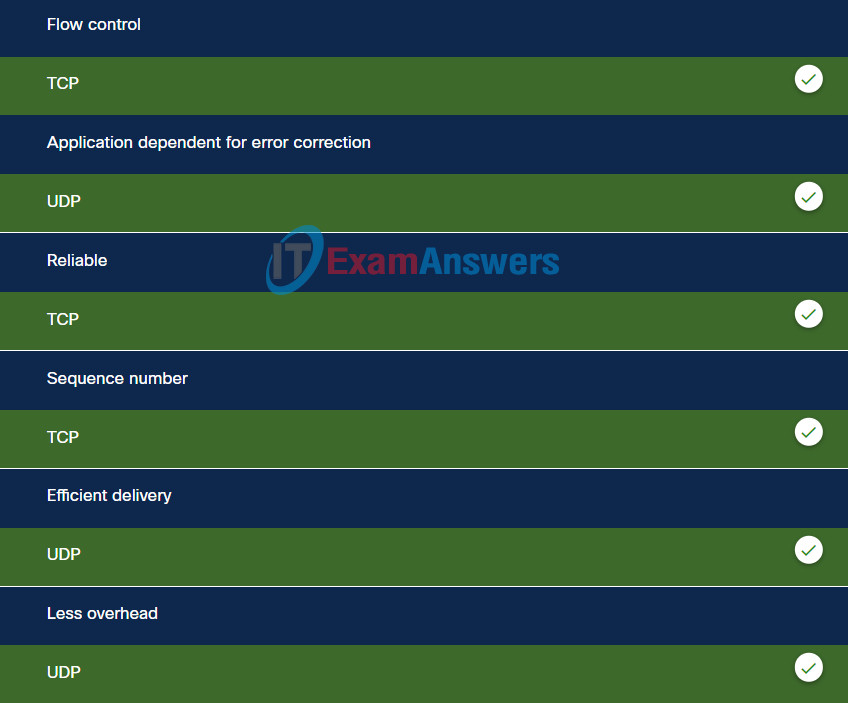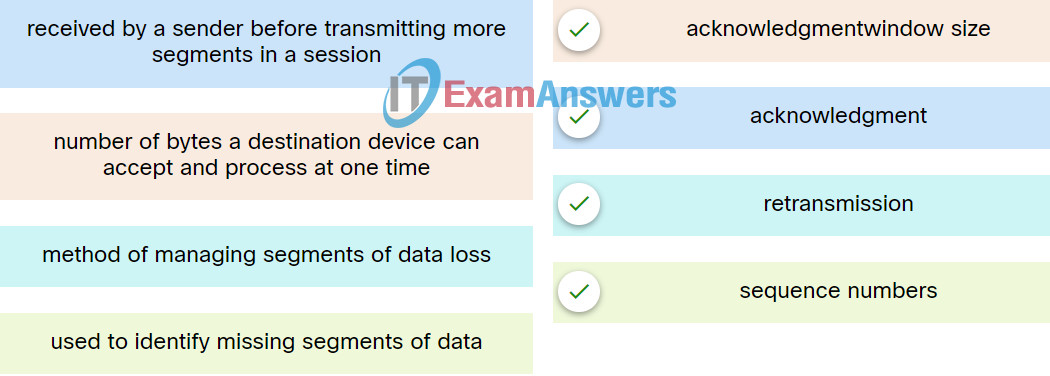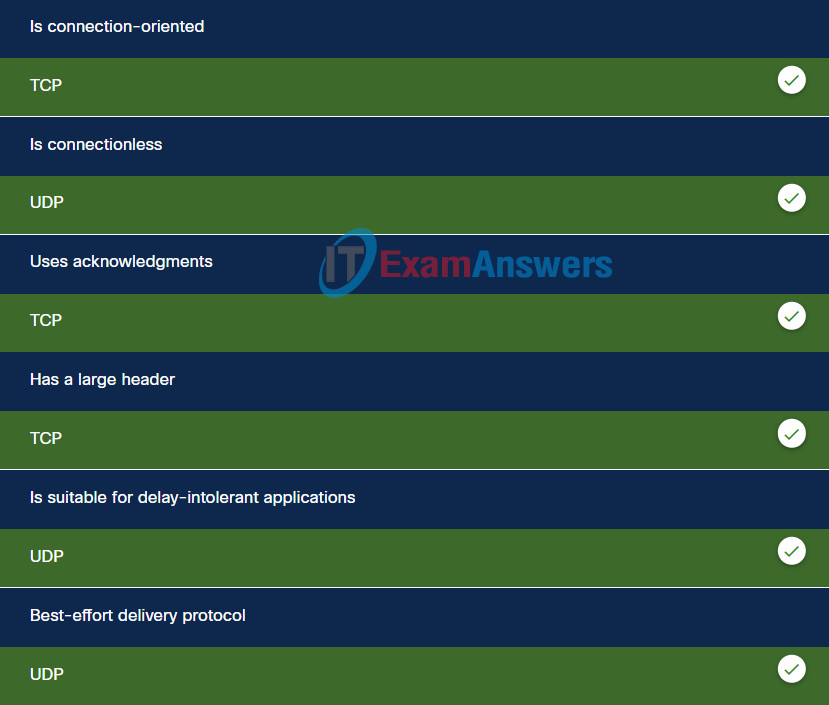Networking Devices and Initial Configuration Module 9.8.4 Transport Layer Quiz Answers
1. Match the characteristics to the correct protocols.

Explanation: Options matched to the correct selection.
| TCP |
UDP |
| Flow control |
Application dependent for error correction |
| Reliable |
Efficient delivery |
| Sequence number |
Less overhead |
2. Which statement correctly describes data transmission at the transport layer?
- Retransmission of lost packets is provided by both TCP and UDP.
- Segmentation is provided by the window size field when the TCP protocol is used.
- A single datagram can include both a TCP and a UDP header.
- Both UDP and TCP use port numbers.
- Segmentation is provided by sequence numbers when UDP is used.
Explanation: Segmentation is handled at Layer 4 by TCP sequence numbers. UDP does not have sequence numbers in the header, but instead, lets the application handle reordering if it is necessary. Only TCP provides reliable deliver and retransmits data. Each segment has either a TCP header or a UDP header; it cannot contain both.
3. Which three fields are used in a UDP segment header? (Choose three.)
- Window Size
- Length
- Source Port
- Acknowledgment Number
- Checksum
- Sequence Number
Explanation: A UDP header consists of only the Source Port, Destination Port, Length, and Checksum fields. Sequence Number, Acknowledgment Number, and Window Size are TCP header fields.
4. What is the last segment sent to complete the termination process of a TCP session that was initiated by a client?
- a segment with the ACK flag set to 1 from the client
- a segment with the FIN flag set to 1 from the server
- a segment with the SYN flag set to 1 from the client
- a segment with the ACK flag set to 1 from the server
Explanation: Terminating a TCP session requires four exchanges of segments between the client and the server.
- The client sends a segment with the FIN flag set to 1.
- The server sends an ACK to acknowledge the FIN.
- The server sends a segement with the FIN flag set to 1.
- The client responds with the final ACK to acknowledge the FIN from the server.
5. What is a characteristic of a TCP server process?
- Every application process running on the server has to be configured to use a dynamic port number.
- There can be many ports open simultaneously on a server, one for each active server application.
- An individual server can have two services assigned to the same port number within the same transport layer services.
- A host running two different applications can have both configured to use the same server port.
Explanation: Each application process running on the server is configured to use a port number, either by default or manually, by a system administrator. An individual server cannot have two services assigned to the same port number within the same transport layer services. A host running a web server application and a file transfer application cannot have both configured to use the same server port. There can be many ports open simultaneously on a server, one for each active server application.
6. Network congestion has resulted in the source learning of the loss of TCP segments that were sent to the destination. What is one way that the TCP protocol addresses this?
- The source decreases the amount of data that it transmits before it receives an acknowledgement from the destination.
- The source decreases the window size to decrease the rate of transmission from the destination.
- The destination decreases the window size.
- The destination sends fewer acknowledgement messages in order to conserve bandwidth.
Explanation: If the source determines that the TCP segments are either not being acknowledged or are not acknowledged in a timely manner, then it can reduce the number of bytes it sends before receiving an acknowledgment. This does not involve changing the window in the segment header. The source does not decrease the window that is sent in the segment header. The window in the segment header is adjusted by the destination host when it is receiving data faster than it can process it, not when network congestion is encountered.
7. Which field in the TCP header indicates the status of the three-way handshake process?
- window
- reserved
- checksum
- control bits
Explanation: The value in the control bits field of the TCP header indicates the progress and status of the connection.
8. What are two features of protocols used within the TCP/IP protocol stack? (Choose two.)
- The Internet Layer IP protocol has built in mechanisms for ensuring the reliable transmission and receipt of data.
- UDP is used when an application must be delivered as quickly as possible and some loss of data can be tolerated.
- TCP and UDP destination port numbers are dynamically generated by the sending device in order to track the responses to requests.
- TCP mechanisms retransmit data when an acknowledgment is not received from the destination system within a set period of time.
- The same Transport Layer source port is used for all of the tabs opened at the same time within a web browser.
Explanation: Application programmers make decisions about which protocols to use to transport the data to and from their applications based on whether the application can tolerate any lost data. Live streaming and voice transmissions can use UDP because if a few data packets are lost, the quality of the video and audio is not seriously impacted. TCP is used when all data must be complete and accurate.
9. Match each description with the corresponding TCP mechanism.

Explanation: Place the options in the following order:
| received by a sender before transmitting more segments in a session |
acknowledgment |
| method of managing segments of data loss |
retransmission |
| used to identify missing segments of data |
sequence numbers |
| number of bytes a destination device can accept and process at one time |
acknowledgmentwindow size |
10. Match the description to either TCP or UDP.

Explanation: Options matched to the correct selection.
| TCP |
UDP |
| is connection-oriented |
is connectionless |
| uses acknowledgments |
is suitable for delay-intolerant applications |
| has a large header |
best-effort delivery protocol |
11. What is a characteristic of the UDP protocol?
- low overhead
- guaranteed delivery
- error correction
- end-to-end establishment before delivery
Explanation: TCP is a connection oriented protocol that provides for error recovery and guaranteed delivery mechanisms while UDP offers connectionless delivery and has fewer fields in the packet header than TCP.
12. Which two flags in the Layer 4 PDU header are set by a client and server to terminate a TCP conversation? (Choose two.)
Explanation: Both the client and server will send a FIN and an ACK flagged segment to end each of the one-way TCP sessions in a single conversation.



